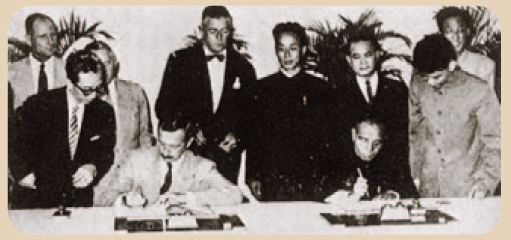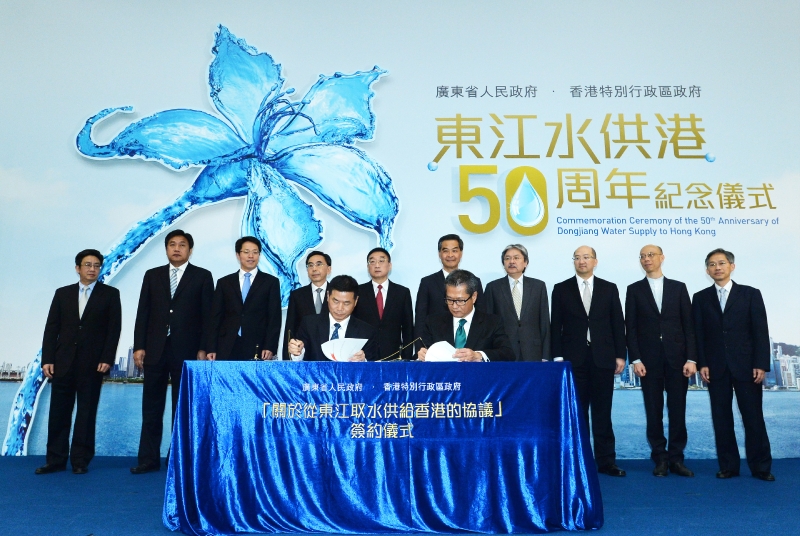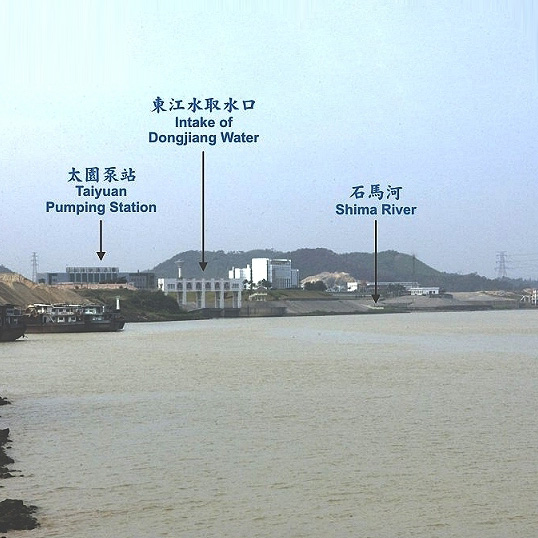In the Mainland
Dongjiang is one of the three tributaries of the Pearl River. Its sources are located at the Xunwu, Anyuan and Dingnan counties of Jiangxi Province and flows from northeast to southwest direction into Guangdong Province. It supplies fresh water for a total of more than 40 million people in Heyuan, Huizhou, Dongguan, Guangzhou, Shenzhen and Hong Kong. DJ water supplied to Hong Kong is originally extracted from Taiyuan Pumping Station at Dongguan and conveyed over a dedicated adequate. It eventually discharges into the Shenzhen Reservoir before being fed by pipelines across the border to Muk Wu Raw Water Pumping Station of Hong Kong.
Subsequent to the commissioning of the dedicated aqueduct system in June 2003, the DJ water supply route is now segregated from all pollution sources along the Shima River.

In Hong Kong
Upon receipt of the DJ raw water at the Muk Wu Raw Water Pumping Station, the DJ raw water is carried through the three major aqueduct supply systems (i.e. Western Route, Central Route and Eastern Route) to some of the water treatment facilities for direct treatment and some designated impounding reservoirs for temporary storage and subsequent treatment at its downstream water treatment works.
Details of the aqueduct supply systems are as follows -
-
Western Route - Through the Western Route, DJ water is delivered to Ngau Tam Mei Water Treatment Works and Au Tau Water Treatment Works for direct treatment, and to Tai Lam Chung Reservoir for temporary storage and subsequent treatment at its downstream water treatment works;
-
Central Route - Through the Central Route, DJ water is delivered to Sheung Shui Water Treatment Works, Yau Kom Tau Water Treatment Works, Tai Po Water Treatment Works and Sha Tin Water Treatment Works for direct treatment, and Plover Cove Reservoir for temporary storage and subsequent treatment at its downstream water treatment works; and
-
Eastern Route - Through the Eastern Route, DJ water is transferred to Plover Cove Reservoir for temporary storage and subsequent treatment at its downstream water treatment works.
(Remark: Subject to operational need, the raw water stored in Plover Cove Reservoir can be transferred to High Island Reservoir for temporary storage)
The aforementioned three Routes are inter-connected through the Tai Po Tau Raw Water Pumping Station complex to provide maximum flexibility in system operation throughout the year. This is particularly crucial during the annual DJ water shutdown period in December when raw water from Plover Cove Reservoir and High Island Reservoir is required to maintain the necessary throughput at the treatment works in Sha Tin, Tai Po and other parts of the territory.
As early as in 1960, the Hong Kong Government was well aware that the increasing fresh water demand in Hong Kong could no longer be satisfied by local yield solely, and the procurement of fresh water from Guangdong Province was the most efficient way for fulfilling the unmet water needs. On 15 November 1960, the Governments of Guangdong Province and Hong Kong reached an agreement on importing 22.7 million cubic metres per year of raw water from the Shenzhen Reservoir to Hong Kong every year.

In 1963, the Governments of Guangdong Province and Hong Kong held several rounds of discussions and reached a consensus on the implementation of the Dongjiang-Shenzhen Water Supply Scheme. The Scheme was approved by Prime Minister Zhou Enlai and granted a special fund by the Central People’s Government for its construction works at the end of the year. Meanwhile, large-scale pumping stations, pipelines and tunnels were constructed in Hong Kong to facilitate the distribution of DJ water to various districts over the territory.

Hong Kong has enjoyed 24-hour uninterrupted water supply since 1982. This is achieved through the Agreement for the supply of Dongjiang water to Hong Kong (Supply Agreement) with the Government of Guangdong Province. The first Supply Agreement was signed in 1960 and up to 2023, thirteen Supply Agreements had been signed. All Supply Agreements were based on consumption projections in Hong Kong. These projections took into account population growth, industry and commercial demands and predictions on local yields from Hong Kong’s gathering grounds.
DJ is not only the major source of fresh water for Guangzhou, Shenzhen, Dongguan, Huizhou, Heyuan, but also has the important task of supplying water to Hong Kong, serving a total population of over 40 million. With average annual per capita water resources of only 1 100 cubic metres, the DJ river basin is regarded as an area of water scarcity according to international assessment standards. Therefore, Guangdong Province implemented a DJ River Basin Water Resources Allocation Scheme, which co-ordinates the annual flow in the river basin according to the total amount of allocated water resources, so as to ensure a reasonable and efficient usage of the limited water resources. In addition, the water resource utilisation rate of the DJ has already reached a level very close to its exploitation limit, indicating a fairly tight supply of water resources.
Hong Kong and Guangdong (GD) are under the same climatic setting (rainfall pattern, temperature, etc.). When our local yield reduces during drought years, the quantity of DJ water available for distribution will also dwindle. We need to agree with the GD side a provision in the supply agreement for ensuring Hong Kong to attain a reliable DJ water supply quantity, otherwise in the event of drought, there will not be any guarantee that our demand can be met. In order to safeguard our water security, the package deal principle is adopted in the current supply agreement which guarantees an annual ceiling of supply quantity with a view to maintaining water supply round-the-clock even under the extreme drought condition with a return period of 1 in 100 years.
"Package Deal Deductible Sum" Approach
The current supply agreement continues to adopt “package deal deductible sum” approach in which a price deduction will be made to the annual ceiling water price according to the actual amount of Dongjiang water supplied. In term of supply quantity, the current supply agreement continues to adopt the package deal principle under which Hong Kong is assured of an adequate DJ water supply up to the annual supply ceiling in the agreements. We would inform the GD side the DJ water supply quantity on a monthly basis, thereby achieving a better control of the storage level in Hong Kong, minimizing water overflow (Fresh water overflow at the reservoirs does not involve DJ water; for details please refer to reservoir overflows.) and saving pumping costs for water delivery. In addition, the annual supply ceiling is obtained on the basis of a detailed analysis taking into account the forecast fresh water demand and local yield to ensure 99% reliability of water supply during the agreement periods.
The current DJ water supply agreement is for a 3-year period from 2024 to 2026 whilst the "package deal deductible sum" approach will be maintained at least up to 2029. A minimum annual DJ water supply quantity of 615 mcm for the current supply agreement, as well as an average annual DJ water supply quantity not be less than 700 mcm during the nine-year period covering the supply agreement from 2021 to 2023, current and subsequent supply agreements are adopted in the current DJ water supply agreement.
National Water Standard
Under the current DJ water supply agreement, the Guangdong authorities would maintain the quality of the DJ water supplied to Hong Kong to meet the national standard set out for Type II waters (applicable to the abstraction for human consumption in first class protection area) in the “Environmental Quality Standards for Surface Water GB3838-2002”. The Government of the Hong Kong Special Administrative Region has all along been maintaining close liaison with the Guangdong authorities on the water quality of the DJ water supplied to Hong Kong through an established institutional mechanism, which includes the Guangdong/Hong Kong Water Supply Business Meeting, Guangdong/Hong Kong Water Supply Operation and Management Technical Cooperation Sub-group Meeting, and the Special Panel on the Protection of DJ Water Quality.
The Guangdong authorities have adopted the following measures to prevent contamination of DJ water supplied to Hong Kong:
- Relocation of the intake point upstream: In 1998, the intake point of DJ water was relocated upstream to a location of better water quality.
- Bio-nitrification Plant: To enhance water quality, a bio-nitrification plant at the Shenzhen Reservoir was commissioned in early 1999.
- Dong-shen dedicated aqueduct: To further significantly improve the quality of the DJ water supplied to Hong Kong, the Guangdong authorities commenced the construction of a dedicated aqueduct from Taiyuan along Dongjiang to the Shenzhen Reservoir in 2000. Since its commissioning in 2003, the quality of the DJ water transferred to Hong Kong has significantly improved.
- Shima River Sewage Diversion Works: The Shima River Sewage Diversion Works was completed in 2005. By making use of a rubber dam, contaminated water from Shima River is deterred from flowing into Dongjiang near the intake point at the Taiyuan Pumping Station. This can further safeguard the quality of the DJ water supplied to Hong Kong.
- Dongjiang Water Resource Protection Works at Shima River Mouth, Stage 1: The works was completed in 2020. Major construction includes a new water gate to intercept sewage at the mouth of the Shima River which replaces the existing rubber dam to further safeguard the quality of the DJ water.
- Comprehensive remediation project at the Sha Wan River Basin: A comprehensive remediation project of the water environment of the Sha Wan River Basin was launched in late 2016 to reduce the risk of Shenzhen Reservoir being polluted by flood discharge from the Sha Wan River in order to protect the water quality of the Shenzhen Reservoir. The project has been completed in 2020.
Water Quality Monitoring
The Water Supplies Department (WSD) has installed a 24-hour on-line monitoring system at the reception point of Dongjiang (DJ) water at the Muk Wu Raw Water Pumping Station to continuously monitor the quality of the DJ water supplied to Hong Kong. Regular DJ water samples are also collected at Muk Wu Raw Water Pumping Station for detailed analysis to ensure that the DJ water supplied to Hong Kong complies with the required standards. The WSD would adjust the water treatment processes at water treatment works as necessary according to the quality of the DJ water to ensure that the quality of the treated water complies with the Hong Kong Drinking Water Standards.
In case of any anomaly in the quality of DJ water, WSD will immediately take suitable measures, including strengthening the monitoring of various parameters of the DJ water quality at Muk Wu Raw Water Pumping Station, adjusting the treatment processes at water treatment works and liaising with the Guangdong authorities for temporary reduction or suspension of the DJ water supply as necessary.
Information about the quality of the DJ Water supplied to Hong Kong
- Water Quality of DJ’s Main Stream as Monitored at the East Bank Section in 2023
The Department of Ecology and Environment of Guangdong Province has been regularly providing the water quality data of the water samples taken at the East Bank Section of DJ’s main stream which is upstream of the intake of DJ water for supplying to Hong Kong at the Taiyuan Pumping Station. The data in 2023 are as follows:
For further information on DJ water quality, please visit the homepage of the Department of Ecology and Environment of Guangdong Province at http://gdee.gd.gov.cn.
- DJ Water Quality for the Period of October 2023 – September 2024 as received in Hong Kong at the Muk Wu Raw Water Pumping Station
The quality of DJ Water supplied to Hong Kong for this period complied with the national standard for Type II waters (applicable to the abstraction for human consumption in first class protection area) in the “Environmental Quality Standards for Surface Water (GB3838-2002)” specified in the DJ water supply agreement. For details please refer to:
Under the “package deal deductible sum” approach, the actual annual water price can be expressed by the following formula:
where the price deduction is calculated as follow:
The annual ceiling water price is adjusted based on the established mechanism which takes account of factors including changes in the exchange rate between Renminbi (“RMB”) and HKD, changes in the relevant price indices of both sides, as well as increases in operation costs. Both the GD and Hong Kong sides agreed the unit rate will be adjusted based on the same percentage change for the annual ceiling water price in the corresponding year.
When negotiating over the current DJ water supply agreement (from 2024 to 2026) in 2023, it was noted that the average annual rate of change in RMB/HKD exchange rate was about +0.83% in the previous three years (from 2020 to 2022). Besides, the average annual rate of change in the relevant price indices of GD and Hong Kong was about +1.56% over the same period. The actual combined rate of change in consumer price indices and RMB/HKD exchange rate is 2.40%. After rounds of negotiations, the GD side agreed the annual supply ceiling to be 820 million cubic metres, and the respective annual ceiling water prices and unit rates for DJ water conserved are shown in the following table:
| Year | Annual ceiling water price (HK$ million) | Change | Unit rate for DJ water conserved (HK$/m3) |
|---|---|---|---|
| 2024 | 5,136.24 | +2.39% | 0.315 |
| 2025 | 5,259.00 | +2.39% | 0.323 |
| 2026 | 5,384.69 | +2.39% | 0.331 |
Taking account of the actual rates of change of RMB/HKD exchange rate and the relevant price indices of GD and Hong Kong during 2020 to 2022, we consider the adjustments in water price reasonable.
The Advisory Committee on Water Supplies (Advisory Committee) is an independent body comprising members from the public including academics, district councilors, green advocates, professionals, trades and officials from related government departments and bureau.
Visit to the DJ Water Supply System has been conducted annually by the members of the Advisory Committee. Through the annual visits, members can be updated on the work in protection of DJ water quality by the GD authorities and have the opportunity of direct dialogue with their officials on DJ water quality.
For more details please refer to The Advisory Committee on Water Supplies website.
A delegation of the Legislative Council (LegCo) Panel on Development conducted a two-day duty visit from 14 to 15 April 2017 to the Dongjiang River Basin in Guangdong Province.
The purpose of the duty visit is for Members to learn about the operation of the Dongjiang-Shenzhen Water Supply System as well as measures taken by the GD authorities in safeguarding the quality of DJ water supplied to Hong Kong. In addition, Members made use of the opportunity to exchange views with the GD authorities on issues of mutual concern related to the supply of DJ water to Hong Kong.
For more details please refer to:



